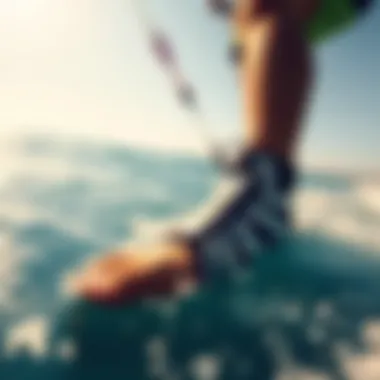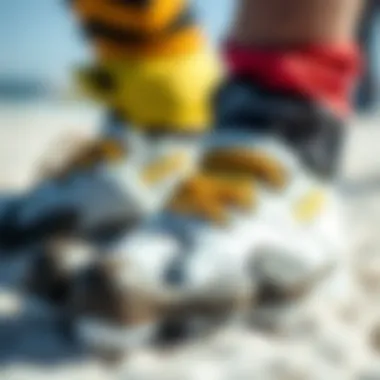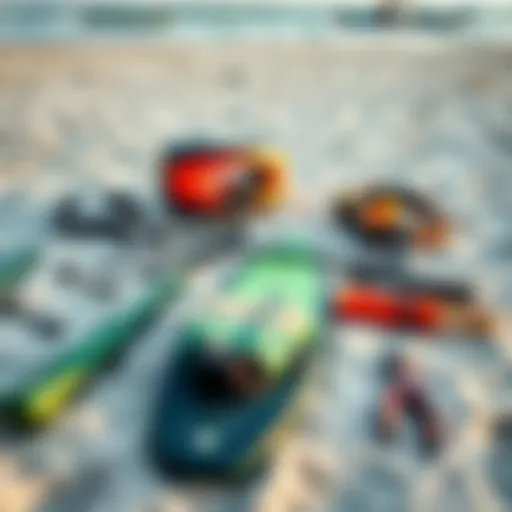Exploring the Benefits of Split Toe Booties in Kiteboarding


Intro
The world of kiteboarding thrives on the thrill of gliding across water, propelled by wind and skill. Within this dynamic sport, choosing the right gear is crucial. Among the essential equipment, the split toe bootie stands out, offering a specialized advantage. This unique footwear is designed not just for style but enhances performance in water sports. Kiteboarders often find themselves in varying water conditions, and the right bootie can make all the difference.
The split toe bootie, with its distinct design, allows for better foot mobility and improved grip on the board, ultimately aiding in responsiveness during gameplay. In this guide, we'll delve into the fine-tuned details of this specialized bootie. We'll examine the materials used, talk about the nitty-gritty of fitting and maintenance, and explore how it can elevate both novice and expert kiteboarders' experiences on the water.
Gear and Equipment
Essential Kiteboarding Gear: A Comprehensive Guide
When it comes to kiteboarding, having the right gear is non-negotiable. The split toe bootie is but one piece of a larger puzzle, although it plays an essential role. Here are the key components every kiteboarder should consider:
- Kite: This is your primary tool. Kites come in various shapes and sizes tailored to different wind conditions. Choosing the right kite makes a substantial impact on performance.
- Board: Suitable boards vary by your skill level. From beginner-friendly options to advanced models designed for tricks, your board is just as vital as the kite.
- Harness: A comfortable and well-fitted harness will give you the support needed to maintain control during your ride.
- Protective Gear: Helmets and impact vests are must-haves for safety, particularly for those learning new maneuvers.
The split toe bootie fits snugly within this list. It helps kiteboarders maintain grip on the board, crucial when the wind picks up or during exhilarating jumps. The design of the bootie also prevents excessive water entry while keeping feet warm.
Maintenance Tips for Kiteboarding Equipment
Taking care of your equipment can dramatically extend its lifespan. Here are some key maintenance tips tailored for kiteboarding gear:
- Regular Inspection: Before each session, check your kite for signs of wear or damage. This includes looking for frays and ensuring all parts are secure.
- Dry Thoroughly: After a day on the water, make sure to rinse your equipment with fresh water to remove salt. Let everything dry fully to prevent mold and decay.
- Storage: When storing your gear, keep it in a cool, dry place. Direct sunlight can damage fabric and reduce the equipment's overall life span.
- Bootie Care: For your split toe booties, use mild soap and water to clean them. Check for any tears, particularly at the seams, and repair them promptly to avoid further damage.
In essence, knowledge about maintaining your gear not only ensures a better performance but also enhances your enjoyment and safety during kiteboarding. Taking these small steps will help you enjoy the thrill of riding the waves for years to come.
Prolusion to Split Toe Booties
The split toe bootie represents a unique segment of footwear, specifically designed to cater to the aquatic sports community, particularly kiteboarding. Understanding this type of boot can significantly enhance a user's performance and overall experience on the water. The split toe design offers distinct benefits that standard booties might not provide, focusing on better grip, quicker drying times, and improved flexibility. With kiteboarding gaining traction among outdoor enthusiasts, exploring the nuances of split toe booties can serve as an essential guide for both novice and seasoned riders alike.
Defining the Split Toe Bootie
A split toe bootie is a specific style of footwear that separates the big toe from the others, somewhat akin to traditional Japanese tabi socks. While at first glance it may seem like a mere design choice, this separation plays a pivotal role. By allowing the big toe to function independently, it enhances balance and grip, especially useful when maneuvering on a board during high-speed rides. These booties come in various materials including neoprene, which contributes to their flexibility and comfort while also providing thermal insulation against cold waters. This design enables better feel and control over the board, making them popular among kiteboarders and surfers.
Historical Context
The origin of the split toe bootie can be traced back to multifunctional footwear designs used in various cultures. Its adoption into water sports began gaining momentum in the mid-20th century as surfing and later kiteboarding developed into mainstream activities. Early models were often made from simple rubber materials, evolving over time into sophisticated blends of synthetic fibers and neoprene. The diversification of water sports led to increased innovation in design and technology, pushing manufacturers to create booties that not only protect but also enhance a rider's capability on the water. The split toe bootie stands out as a culmination of this evolution, showcasing how practical needs influenced functional design in recreational gear.
"Innovation in sports gear like the split toe bootie has not only transformed performance but has also reshaped how enthusiasts engage with their environment."
In summary, split toe booties have a rich history intertwined with the development of water sports, underlined by the practical benefits they deliver. As more kiteboarders seek out high-performing gear, understanding the characteristics and origins of this specialized boot will be key in choosing the right equipment for their adventures.
Design Features of Split Toe Booties
The design features of split toe booties play a crucial role in their functionality, comfort, and overall performance—especially for water sports aficionados. These characteristics set them apart from traditional footwear, enabling a more tailored experience for activities such as kiteboarding. By examining the subtleties in structure, material, and comparison with standard booties, we can comprehensively understand what makes the split toe bootie a notable choice for enthusiasts.
Anatomy of the Split Toe Bootie
Toe Separation Structure
One of the unique aspects of the split toe bootie is its toe separation structure. This design allows for each toe to move independently, mimicking the natural position of the foot. The major advantage here is improved dexterity—an essential factor when navigating the complexities of kiteboarding. By splaying out the toes, the bootie maximizes grip on the board, allowing for better command and stability, which is often pivotal in challenging conditions.
While some may find the toe separation odd, it significantly enhances balance. Just as a dancer relies on their feet to maintain poise, a kiteboarder benefits from the split design when making quick maneuvers. In terms of drawbacks, some users might experience an initial adjustment period as their feet adapt to the new positioning. However, this can usually be rectified with a bit of practice.
Material Choices
The choice of materials in split toe booties is another deciding factor in their appeal among water sports aficionados. Typically made from neoprene and other high-performance synthetics, these materials are not only lightweight but also have excellent stretchability. This allows for a snug fit that doesn’t compromise on comfort.
Additionally, neoprene offers insulation, which is invaluable when wading into cooler waters. A key characteristic of this material is its resilience and flexibility—it can withstand the rigors of various water sports while maintaining its integrity over time.


However, there’s a balance to be struck here. While neoprene provides insulation, it might not be suitable for warmer climates where breathability becomes essential. In such cases, material blends that incorporate mesh can be beneficial but may compromise on thermal protection. Ultimately, users must consider the climate and type of water activities they engage in to make the best choice.
Comparative Analysis with Standard Booties
Performance Benefits
When it comes to performance, the split toe bootie truly has the edge over standard booties. The separation of the toes promotes a natural foot movement, aligning with the board better and ensuring heightened responsiveness. This improved control is vital for practitioners who require precision in their movements, particularly in dynamic environments like the ocean or a river. It’s not just about functionality, though; the comfort level provided by this design means fewer distractions during a ride.
On the flip side, beginner kiteboarders might find it a bit challenging at first to adapt to the split design and may prefer a standard bootie until they are confident in their skills. However, once they adjust, the performance benefits start to shine.
Durability Factors
Durability is another compelling point of discussion when comparing split toe booties to their standard counterparts. These booties, when crafted with quality materials like high-density neoprene, can boast longer lifespans. Their reinforced toe and heel areas are designed to endure constant friction against the board and other surfaces, helping them resist wear and tear.
One might argue that cost is an initial concern; however, the longevity of a split toe bootie often justifies the investment. A more durable boot can save money in the long run, eliminating the need for frequent replacements, which is particularly beneficial for active users. Additionally, while some users may experience issues with seams over time, many newer models leverage advanced stitching techniques, enhancing durability without sacrificing flexibility.
Functionality in Water Sports
The split toe bootie plays a vital role in water sports, especially for activities such as kiteboarding. Its unique design contributes significantly to enhancing performance and ensuring safety in diverse water conditions. Understanding its functionalities helps both novice and experienced kiteboarders appreciate what these booties offer, ensuring feet stay protected while maximizing mobility on the board.
Performance Enhancement
Grip and Traction
A standout feature of the split toe bootie is its extraordinary grip and traction. Given that water sports often take place in slippery conditions, this characteristic can make or break a ride. The split toe design allows for a more natural foot placement, improving balance and control. Many booties boast rubber outsoles with specific tread patterns designed to claw at any slick surface, providing superior grip on the board and minimizing the risk of slipping.
One important aspect here is the high-friction material typically used on the soles. This not only offers enhanced traction but adapts to various surfaces, from wet boards to grassy beaches, making it a popular choice among outdoor enthusiasts. Each step seems to feel more secure, giving users confidence to push their limits in their water adventures. However, one might argue that this specialization leads to a sacrifice in flexibility in some booties, hence making it essential to choose the right model for the right sport.
Flexibility
Flexibility is another key aspect to consider when diving into the functionality of split toe booties. This quality directly influences how one maneuvers while kiteboarding. The construction of these booties often incorporates elastic materials that bend easily, allowing the feet to move naturally without restrictions. This flexibility enhances an athlete's performance by enabling quick changes in direction and speed, which is critical when navigating through waves and gusts of wind.
The flexible design helps in reducing fatigue, enabling longer sessions on the water without discomfort. While it may seem that increased flexibility might lead to less protection, the best models provide a balance, ensuring safety without compromising on comfort. Selecting a bootie with proper flexibility means the rider can engage fully with the board, delivering a more dynamic riding experience.
Thermal Protection
Finally, thermal protection is an often-overlooked benefit of split toe booties. Water temperatures can drop significantly, especially in early morning or late-season kiteboarding. Having the right booties that provide insulation can keep one's feet warm and functional, preventing numbness that can lead to less control over the board. Manufacturers typically use neoprene or similar materials in their designs, which not only provide warmth but also aid in buoyancy.
Several models even feature thermal linings, acting as a barrier against the cold while allowing moisture to escape, which keeps the feet dry during those prolonged outings on the water. For kiteboarders looking to make the most out of their sessions during cooler periods, the significance of thermal protection cannot be overstated. It becomes a decisive factor in determining not just comfort, but also performance.
In summary, the functionality of split toe booties encompasses a combination of grip, flexibility, and thermal protection, fundamentally tailored for enhancing water sports performance. Each of these aspects intertwines to create a comprehensive footwear solution for kiteboarding. By focusing on these functional elements, both novices and veterans can ensure they select the right booties for their respective needs, enhancing their overall experience on the water.
"Choosing the right gear can be the difference between an exhilarating day on the waves and a frustrating trip to the beach."
For more insights into gear choices, check out Kiteboarding Magazine or discussions on Reddit.
Fit and Comfort Considerations
The fit and comfort of split toe booties are crucial aspects that can make or break the performance of a kiteboarder on the water. A well-fitting bootie serves not only to protect the feet but also to enhance the overall experience when navigating through waves and wind. When a bootie is snug yet comfortable, it translates into better control and responsiveness during rides. Essentially, the right fit can elevate both the safety and efficiency of the wearer, allowing them to focus on honing their skills or simply enjoying the water.
Sizing and Fit Tips
Getting the sizing right on a split toe bootie is like finding the perfect needle in the haystack. First, it’s essential to understand that sizes may vary between brands. Although a brand may state a size, the actual fit can be off, leading to discomfort and performance issues. Here are some tips to ensure your bootie fits like a glove:
- Measure Your Feet: Take your foot measurements in both length and width. This helps narrow down the best size when checking sizing charts.
- Try Them On: If purchasing at a store, wear the booties and walk around. Check for pressure points, as areas that feel tight may lead to blisters during prolonged use.
- Consider Thickness of Socks: If you plan to wear socks, account for this extra material in your sizing decision.
- Fit over the Ankle: Opt for booties that cover the ankle snugly. This reduces water entry and provides better warmth in cooler conditions.
A bootie that doesn't fit well is like a sailor with a ripped sail; it hinders progress and lessens enjoyment.


Adjustability Features
In a sport like kiteboarding, conditions can shift as quickly as the wind. Having adjustable features in your split toe bootie can significantly enhance comfort and performance. Key features to look for include:
- Velcro Straps or Buckles: These allow for easy tightening or loosening based on preference or water conditions. A secure fit can help in maintaining optimum control on the board.
- Elastic Panels: Some models may incorporate elastic materials that provide flexibility, allowing for movement without sacrificing support.
- ankle Gaiters: Adjustable gaiters can help seal the bootie around the foot and leg, preventing water from entering while maximizing warmth.
Ultimately, both sizing and adjustable features play a vital role in maximizing wearability of split toe booties, enhancing not just comfort but overall performance on the water.
Maintenance and Care
Maintaining split toe booties is not just about keeping them looking fresh; it plays a crucial role in extending their lifespan and ensuring top-notch performance in water sports. With the rigors of outdoor activities, proper care can mean the difference between a one-season investment and a long-term addition to your gear. The salty sea, sandy beaches, and murky lakes can take a toll on footwear, making attention to maintenance vital for kiteboarders and outdoor enthusiasts alike.
Taking the time to clean and store your split toe booties properly can help combat issues commonly faced by water sports enthusiasts, such as premature wear and loss of grip. This section breaks down essential cleaning techniques and storage practices that every kiteboarder should master.
Cleaning Techniques
Cleaning your split toe booties is an essential task. After a day of kiteboarding, they can accumulate dirt, sand, and salt, all of which can affect performance and comfort. Here are some effective techniques to keep them in top shape:
- Rinse Immediately: Right after use, rinse your booties with fresh water. This simple act helps remove salt and sand that can damage material over time.
- Hand Wash: Use a mild soap or specialized footwear cleaner to scrub your booties gently using a soft brush. Focus on the toe separation area to eliminate trapped dirt.
- Air Dry: Avoid direct sunlight and heat sources. Stuff them lightly with newspaper or a similar material to help retain their shape while they dry naturally in a cool, shaded area.
"A little care goes a long way. Your gear deserves it!"
By dedicating a few moments to this cleaning ritual, you can stave off the deterioration that worry often follows water sports gear.
Storage Practices
Once you've cleaned your booties, paying attention to how you store them is equally important. Proper storage can prevent deformation and prolong their usefulness. Here are some effective practices:
- Avoid Squishing: Store your split toe booties standing up rather than folded or squeezed together with other items. This helps maintain their shape.
- Cool and Dry Place: Keep them in a well-ventilated area, away from heat sources, to prevent any warping or degradation of materials.
- Use a Dedicated Bag: Consider using a mesh bag specifically designed for wetsuit and bootie storage. This allows excess moisture to evaporate while keeping them in a tidy location.
Keeping your split toe booties well-maintained through proper cleaning techniques and storage practices ensures they remain a reliable companion in your water adventures. By giving some thought to how you care for and store your gear, you'll not only enhance performance but also maximize enjoyment on the water from season to season.
Recommendations for Various Skill Levels
When it comes to choosing the right split toe bootie, understanding the varying needs based on skill levels is crucial. Kiteboarding, as an activity, demands different things from gear depending on whether one is just starting out or is an experienced rider. The goal of this section is to provide insights that streamline the decision-making process, ensuring that our readers, particularly kiteboarders, outdoor enthusiasts, and sports instructors, make informed choices that enhance their performance on the water.
Beginner Considerations
For newcomers, the landscape of water sports can seem a bit daunting. They might be eager to hit the waves but often lack knowledge about what specific gear will serve them best. Split toe booties shouldn't just be seen as a trendy piece of footwear; they play a pivotal role in safety and comfort.
Here are some key aspects beginner kiteboarders should consider:
- Fit is Key: A snug fit can make all the difference. Booties that are too loose can lead to blisters and discomfort. Beginners should look for adjustable features or sizes that cater specifically to their foot shape.
- Material Flexibility: Soft materials tend to provide comfort without compromising on performance. Neoprene options are particularly popular, as they allow for movement while still providing warmth.
- Thickness Matters: Novices should think about the thickness of the booties. Thicker materials provide more insulation—ideal for colder waters, but they may sacrifice maneuverability. A mid-range thickness could be a sensible starting point.
- Price Point: While high-end models offer fantastic features, they might not be necessary for those just starting out. A moderately priced option might suit beginners better until they better understand their specific needs.
"Choosing the right gear at the beginning can set the tone for an entire kiteboarding journey. Comfort and fit should top the list of priorities."
Advanced User Insights
For seasoned kiteboarders, the landscape shifts dramatically. Experienced individuals know that the right gear can either make or break their performance. Split toe booties, while still serving the basic functions of keeping feet warm and protected, can also enhance performance in several nuanced ways:
- Precision Fit: Advanced kiteboarders often prefer a tighter fit that allows for maximum control over their movements. They should look for booties that offer options for a custom fit or those with specialized lacing mechanisms.
- Material Upgrades: At this level, materials that provide robustness and durability are essential. Options like titanium-infused neoprene can provide increased warmth without bulk. Advanced users should also pay attention to features like reinforced areas that resist wear from foot straps.
- Performance Features: Some booties come loaded with performance-enhancing features such as specialized tread patterns for superior grip on the board. Advanced kiteboarders should be on the lookout for models that offer enhanced traction without compromising flexibility.
- Adaptability: For those who might engage in other water sports aside from kiteboarding, it's worth checking out booties that can serve multiple purposes. Versatile designs can save space in gear bags and meet different demands whether surfing, wakeboarding, or other activities.
Understanding these diverse needs ensures a strong foundation for every skill level, allowing enthusiasts to embark on their kiteboarding journey effectively, no matter their experience. This deliberation also reflects the evolving nature of water sports, where the right equipment becomes more than just a functional necessity; it embodies a gateway to both learning and mastery.
Integration with Kiteboarding Gear
The interplay between split toe booties and kiteboarding gear is not just a passing thought; it's at the very core of optimizing one’s performance on the water. Kiteboarding demands agility, balance, and a level of connection to the board that can only truly be achieved with the right setup. Split toe booties play a pivotal role in this, marrying functionality and comfort with the requirements of kiteboarding experts and novices alike.


One crucial aspect to consider here is how these booties work with harnesses. The properly designed split toe bootie fosters a snug fit that embraces the foot's structure, allowing for precise control over the board while cushioning against prolonged exposure to the elements.
Compatibility with Harnesses
When kiteboarding, the harness acts as a vital point of connection between the rider and the kite. A split toe bootie that harmonizes well with harnesses can enhance this connection, offering superior response times and ultimately improving the rider's performance.
Key Points on Compatibility:
- Seamless Interaction: The split design enables the toes to articulate more freely, which can help in the effective engagement of the harness.
- Reduction of Pressure Points: A well-fitting bootie minimizes any discomfort caused by harness lines digging into your feet while providing robust support.
- Customized Adjustability: Some advanced models of split toe booties come equipped with adjustable features that cater to different harness types, ensuring a snug fit across various gear choices.
Influence on Performance Equipment Choices
The selection of a split toe bootie directly influences other equipment selections, enhancing the kiteboarding experience overall. When the bootie aligns with the entire kiteboarding setup, various synergistic advantages can be realized.
Factors Affecting Performance Equipment:
- Footwear Versatility: A split toe bootie can complement various kiteboarding setups, allowing riders to switch between boards or even engage in other water sports with minimal adjustments needed.
- Performance Synergy: The choice of materials in split toe booties can enrich the overall setup, as advanced neoprene or insulated fabrics enhance protection without sacrificing flexibility or feeling.
- Weight Considerations: Lightweight designs of split toe booties mean that the overall gear weight remains low, directly impacting maneuverability and responsiveness—a likely necessity when catching high winds or powerful waves.
"The right bootie can transform your kiteboarding experience, allowing for a seamless connection with your gear that feels almost second nature."
In summary, understanding how split toe booties integrate with kiteboarding gear opens a door to enhanced performance and comfort. A harmony between the booties and harnesses offers immense benefits in movement and responsiveness, while their influence on equipment choices should not be overlooked. For any kiteboarding enthusiast aiming to elevate their game, these booties are undoubtedly a key consideration.
User Feedback and Reviews
User feedback and reviews hold significant weight, especially in specialized equipment like split toe booties. They provide potential buyers with insights from those who have already taken the plunge, allowing them to make informed choices. Such input can highlight both the distinct advantages and potential pitfalls that come with a bootie designed for water sports, particularly kiteboarding.
Feedback goes beyond mere opinions; it uncovers critical aspects of how these booties perform in real-world conditions. Moreover, they reveal user experiences regarding comfort, fit, and functionality, guiding innovations in design and manufacturing. Understanding what kiteboarders and outdoor enthusiasts have to say helps gear manufacturers tailor their products to meet actual user demands, raising the overall quality of offerings available in the market.
Positive Experiences
A multitude of users rave about their split toe booties, particularly praising the improved maneuverability they provide. Many kiteboarders highlight how the split toe design allows for better foot-to-board connection, making it easier to execute tricks and navigate the waves. The enhanced grip provided by these booties allows them to feel more secure when flying through the air or riding choppy waters.
Additionally, some users note the level of comfort these booties offer. With their flexible materials, they are often described as feeling like a second skin, allowing for freedom of movement without sacrificing protection against the elements. This comfort becomes particularly pivotal during extended sessions on the water, where foot fatigue can deter even the most passionate thrill-seekers.
"I absolutely love my split toe booties. They fit snugly and allow me to feel every detail of the board beneath me. It’s like having better 'feet' connection with the kite!"
Common Critiques
However, it’s not all sunshine and rainbows. A consistent critique among users is the sizing inconsistencies that can lead to issues with fit. Some customers report that while some sizes fit perfectly, others require a difficult exchange process to find the right match. This is particularly problematic for overseas purchases where return policies may be stringent and shipping costs can add up.
Another point of feedback relates to the durability of certain brands. While some manufacturers create robust booties that can withstand intense usage, others tend to wear out quickly, leading to disappointment. Users often comment on the need for improved materials that can better endure prolonged exposure to saltwater and sand.
In sum, while many feedback experiences highlight the overall positives of split toe booties, potential buyers are encouraged to carefully sift through user reviews. This way, they can better understand their preferences and requirements. Keeping an eye on both positive testimonials and common critiques can lead to a well-rounded decision that enhances their waterborne adventures.
Future Trends in Water Footwear
The realm of water footwear is burgeoning with potential as innovations drive both performance and user experience to new heights. For enthusiasts of kiteboarding and related water sports, staying abreast of these trends isn't just a sideline—they are crucial for informed purchasing and gear preparation. As we peer into the future, several key aspects are emerging that promise to redefine the nature of footwear designed for aquatic activities.
Innovations in Material Science
The pace of material innovation in water footwear is being shaped by advancements that prioritize lightweight design, durability, and comfort. Researchers and manufacturers alike are exploring a variety of materials that improve both the performance and environmental impact of water shoes.
- Advanced Synthetic Fabrics: These new-age materials offer enhanced breathability and water resistance that are critical for reducing drag while maintaining comfort upon use in varying aquatic conditions. Nano-coatings might be on the rise, providing further enhancements in water repellency while remaining soft against the skin.
- Recyclable Composites: As sustainability becomes a buzzword across industries, water footwear manufacturers are seeking ways to harness recyclable materials. This move could potentially lead to products that are not only high performance but also more environmentally friendly, setting a positive precedent for reducing waste within the sport.
- Smart Textiles: We might soon see the integration of smart technologies that can track performance metrics or even adjust to changing conditions in the water. Imagine a bootie that can analyze your movement and adjust insulation properties when the temperature fluctuates. This is not just science fiction—it is closer than we think.
"The future of water footwear lies in a mix of performance and sustainability that caters directly to the dynamic needs of water sport enthusiasts."
Design Trends to Watch
Design in water footwear is also evolving, with aesthetics and functionality becoming equally weighted in importance. New trends reflect a balance of style, user customization, and enhanced functionality.
- Minimalist Aesthetic: Many upcoming designs favor a sleek, minimal look that embodies simplicity while maximizing efficient water flow. This not only caters to personal tastes but can also contribute to performance advantages by reducing excess material.
- Modular Designs: Adaptability is becoming desirable—water footwear that features interchangeable components allows users to modify their booties based on conditions or personal preference. This could mean changing out soles for more grip or insulation, depending on the day's weather.
- Bold Patterns and Colors: There's also a shift towards more vibrant and intricate designs that showcase a sense of personality and individuality. This trend may encourage younger users or new enthusiasts to embrace water sports, as expressive footwear can play a role in a broader lifestyle statement.
In summary, future trends in water footwear are set to enhance not just performance but also the user experience through innovative materials and design philosophies. Staying ahead of these shifts can empower kiteboarders and other water sport aficionados to gear up for success and an enjoyable ride on the waves.















